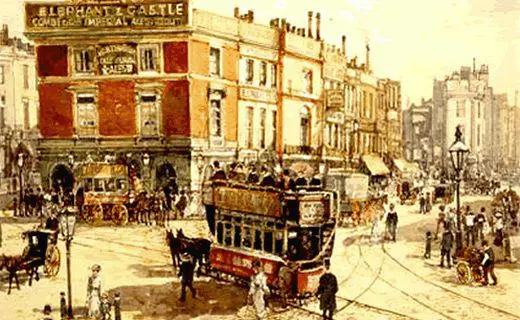In 1829, the Metropolitan Police was founded by Home Secretary Sir Robert Peel (hence the nickname "Bobbies"). By Conan Doyle's birth in 1859, there were over 200 police constabulary units in England and Wales, under the jurisdiction of individual counties. As Conan Doyle represents them in the Sherlock Holmes stories, the constabularies were highly bureaucratized organizations that did things "by the book"; constables themselves tended to be seen as good-intentioned, but plodding, and not always successful. Luckily, unlike Inspectors Lestrade and Hopkins, Holmes's erstwhile colleagues, the Metropolitan Police was not actually forced to match wits with Holmes's brilliant nemesis, Moriarty, leader of the most insidious criminal syndicate in England.
"It is my belief, Watson, founded upon my experience, that the lowest and vilest alleys in London do not present a more dreadful record of sin than does the smiling and beautiful countryside.… The pressure of public opinion can do in the town what the law cannot accomplish. There is no lane so vile that the scream of a tortured child, or the thud of a drunkard's blow, does not beget sympathy and indignation among the neighbours, and then the whole machinery of justice is ever so close that a word of complaint can set it going, and there is but a step between the crime and the dock. But look at these lonely houses, each in its own fields, filled for the most part with poor ignorant folk who know little of the law. Think of the deeds of hellish cruelty, the hidden wickedness which may go on, year in, year out, in such places, and none the wiser."
from "The Adventure of the Copper Beeches"
England has seen a century of upheaval since the first Sherlock Holmes stories burst upon the scene. The old, mysterious London has melted away with its "pea-soup" fogs and plagues of sewer gas; British colonies have gained their independence, one by one; manor houses are as likely to be museums or bed and breakfast inns as private residences. The problems faced by modern British society would seem to have left the Victorian detective behind. Not so: the character that Conan Doyle considered unworthy of his serious literary aspirations still strikes a chord with modern audiences. As the world changed around him, Sherlock Holmes, the reassuring protector of British superiority, transcended his time, and today is loved for his weaknesses and eccentricities as much as for his strengths. In the 21st century, sequels and pastiches featuring the quintessential detective are still being produced at a steady rate.

“Elephant and Castle” by John Sutton
Arthur Conan Doyle's original readers recognized their city and their time in the Sherlock Holmes stories. It was easy to imagine that he was just around the corner, riding in the next hansom cab. No wonder so many people believed that Holmes was real. Today, we can return to those stories to immerse ourselves in the dank vapors and dark alleyways of London, and glimpse another world in all of its splendor and squalor.
Arthur Conan Doyle and The Strand Magazine
Popular literature, such as the Sherlock Holmes stories, came of age along with another 19th-century innovation: the popular magazine. Magazines had existed in some form since the 18th century, but they had never been as cheap or as generally available. This new medium demanded art forms that could be consumed in small bites: on a train trip, or during a few leisure moments after a busy day. In earlier times, literacy generally extended only as far as the middle class, but, with the Education Act of 1870, elementary-school education became compulsory across England. Changing labor laws had given workers more leisure time and disposable income. Increased train travel, especially the advent of daily commuting, triggered a demand for light reading material. Typesetting, although still a complex and labor-intensive technology, had improved to the point where printing houses could mass-produce high-quality material that included photographs and engravings. Finally, the onerous Stamp Tax had been reduced, making printed material more widely affordable.
Publishers quickly learned to target their publications to the needs of particular segments of the population. Working-class people with an elementary-school education read "penny weeklies" such as Tit-bits, which contained short articles, bits of interesting information (what we might call "sound-bites"), and serialized stories. For the middle class, especially those with intellectual aspirations, magazines provided more in-depth articles on politics, science, history, economics, and the arts, as well as fiction that appealed to slightly more developed tastes than what appeared in Tit-bits.
Founded in January 1891, The Strand Magazine, named after a fashionable London street, was aimed squarely at its target audience's middle-class tastes.
1 comment